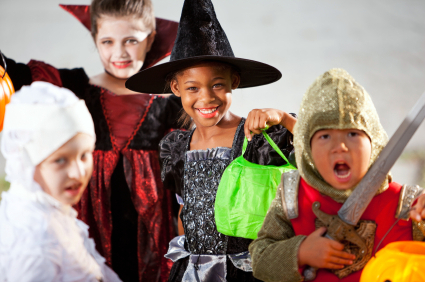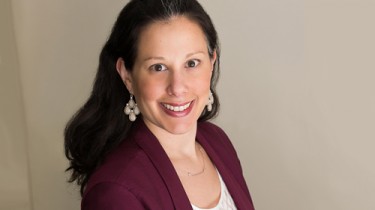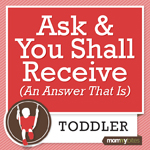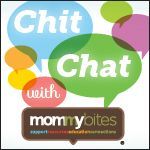
It’s hard to believe that it’s already fall and school is well underway. Along with apple picking and homework, it also means that Halloween is fast approaching. For many kids, this is a very exciting time because it means two incredibly important things – costumes and candy!
But while it’s easy to get the toothbrush and floss ready for a night of too much sugar, thinking about costumes that are age appropriate can be a little more complicated. And with the recent “Creepy Clown epidemic” causing anxiety and consternation in schools and neighborhoods, navigating Halloween may be a little more fraught than usual this year.
Children, often young ones, have strong opinions about what they want to be for Halloween. While it may not seem very important, it’s a great opportunity to engage your child in a discussion about what they want to be and why. For example, “I know you really like Star Wars. That’s so cool that you want to be a Jedi.” It’s never too early to encourage your child to be a creative thinker or assert his/her preferences.
When your child chooses a costume that meshes with your beliefs about what is age appropriate or the right amount of silly or spooky, the whole process can be pretty easy. You make (or if you are me, buy) the costume and wait for October 31st. But what happens when things get more complicated?

Here’s some advice to help you navigate two common pitfalls of the costume choosing process.
“Too sexy” for Halloween
A lot of girls’ Halloween costumes are very sexualized. This is sadly a trend seen in many clothing stores year-round, but it’s even more apparent during Halloween, when the skirts get shorter, the necklines get lower, and the same costumes for boys and girls look different. I’ve seen everything from sexy cat costumes to a sexy SpongeBob SquarePants.
Letting girls wear sexually provocative costumes sends the message that it’s healthy for little girls to dress like women and exhibit adult sexuality. If your child asks your opinion about a Halloween costume, be honest. Offer ideas for costumes that are appropriate for the child’s age and offer a chance to portray a positive and strong female figure (like Marie Curie, Jane Goodall or even Katniss Everdeen).
It’s normal for kids to want to buy what they see in stores and on TV; however, they might not understand how inappropriate the costume is, especially when they see other girls wearing them. Your tween may have her heart set on being a vampire, and there might not be any non-sexy options at the store, making things extra stressful.
In a situation like this, work with your child. For example, if the skirt is too short she can wear a different skirt, or add leggings. It’s important to encourage kids to express their creativity and have fun, but in a way that is appropriate. Be clear and firm about your boundaries, and at the same time help them understand that you want them to have fun.
Too Scary or Too Gruesome
Some costumes may be too violent and gory for children, particularly younger kids. Schools usually have guidelines for what is allowed in terms of masks, gore and weapons. This doesn’t mean your child’s costume has to be smiley and happy. It’s fun to play a villain, and some kids like to be spooky things.
Help your child choose their costume while reminding him or her 1) that other children might find something very scary even if your child doesn’t, and 2) what they wear may need to be slightly modified for school. My son plans to be Kylo Ren from Star Wars – but the light saber and mask will stay home for the school part of the day.
Happy trick or treating!
Like what you read? Sign up for our free newsletter so you can be informed of the latest FREE webinars & teleclasses, parenting articles, & weekly raffles.
 Rachel Busman, PsyD, is a Senior Clinical Psychologist and director of the Selective Mutism Service at the Child Mind Institute. She leads a team of clinicians providing evaluation and innovative treatment to children with selective mutism. She is also a clinical psychologist in the Anxiety and Mood Disorders Center. Dr. Busman has extensive experience providing cognitive behavioral therapy (CBT) to children, teenagers and young adults struggling with anxiety disorders, school difficulties and behavioral problems. She also has specific interest and expertise in the evaluation and treatment of obsessive-compulsive disorder, separation anxiety disorder, social anxiety disorder and specific phobias.
Rachel Busman, PsyD, is a Senior Clinical Psychologist and director of the Selective Mutism Service at the Child Mind Institute. She leads a team of clinicians providing evaluation and innovative treatment to children with selective mutism. She is also a clinical psychologist in the Anxiety and Mood Disorders Center. Dr. Busman has extensive experience providing cognitive behavioral therapy (CBT) to children, teenagers and young adults struggling with anxiety disorders, school difficulties and behavioral problems. She also has specific interest and expertise in the evaluation and treatment of obsessive-compulsive disorder, separation anxiety disorder, social anxiety disorder and specific phobias.
The views and opinions expressed on this blog are purely the blog contributor’s. Any product claim, statistic, quote or other representation about a product or service should be verified with the manufacturer or provider. Writers may have conflicts of interest, and their opinions are their own.



